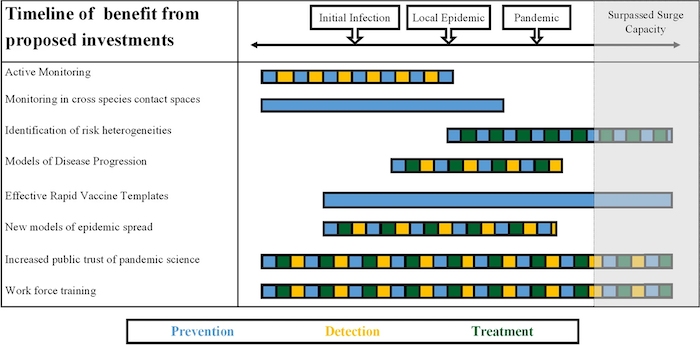
RYAN – A New Paradigm for Pandemic Preparedness
Nina H. Fefferman, John S. McAlister, Belinda S. Akpa, Kelechi Akwataghibe, Fahim Tasneema Azad, Katherine Barkley, Amanda Bleichrodt, Michael J. Blum, L. Bourouiba, Yana Bromberg, K. Selçuk Candan, Gerardo Chowell, Erin Clancey, Fawn A. Cothran, Sharon N. DeWitte, Pilar Fernandez, David Finnoff, D. T. Flaherty, Nathaniel L. Gibson, Natalie Harris, Qiang He, Eric T. Lofgren, Debra L. Miller, James Moody, Kaitlin Muccio, Charles L. Nunn, Monica Papeș, loannis Ch. Paschalidis, Dana K. Pasquale, J. Michael Reed, Matthew B. Rogers, Courtney L. Schreiner, Elizabeth B. Strand, Clifford S. Swanson, Heather L. Szabo-Rogers & Sadie J. Ryan
Article first published online: 9 November 2023
DOI: https://doi.org/10.1007/s40471-023-00336-w
ABSTRACT: Preparing for pandemics requires a degree of interdisciplinary work that is challenging under the current paradigm. This review summarizes the challenges faced by the field of pandemic science and proposes how to address them. The structure of current siloed systems of research organizations hinders effective interdisciplinary pandemic research. Moreover, effective pandemic preparedness requires stakeholders in public policy and health to interact and integrate new findings rapidly, relying on a robust, responsive, and productive research domain. Neither of these requirements are well supported under the current system. We propose a new paradigm for pandemic preparedness wherein interdisciplinary research and close collaboration with public policy and health practitioners can improve our ability to prevent, detect, and treat pandemics through tighter integration among domains, rapid and accurate integration, and translation of science to public policy, outreach and education, and improved venues and incentives for sustainable and robust interdisciplinary work.
Read the full publication in Topical Collection on Infectious Disease.